Not Sphere
We know a unit sphere will look like a unit circle when viewed from any direction.
Now, we have a solid which has the silhouette of a unit circle when viewed from the top, front, or side (from perpendicular directions).
Find the maximum volume of this solid.
The answer is 4.686.
This section requires Javascript.
You are seeing this because something didn't load right. We suggest you, (a) try
refreshing the page, (b) enabling javascript if it is disabled on your browser and,
finally, (c)
loading the
non-javascript version of this page
. We're sorry about the hassle.
5 solutions
I don't understand the expression A (z)
I reasoned out the shape as the intersection of three cylinders
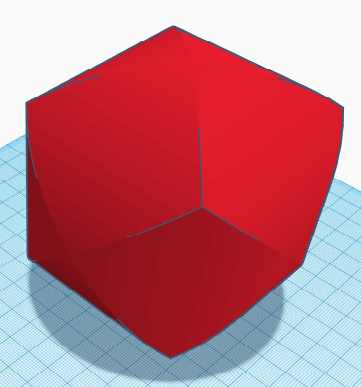 This shape can also be thought of as an interior cube of side
2
with a curved cap on each side
This shape can also be thought of as an interior cube of side
2
with a curved cap on each side
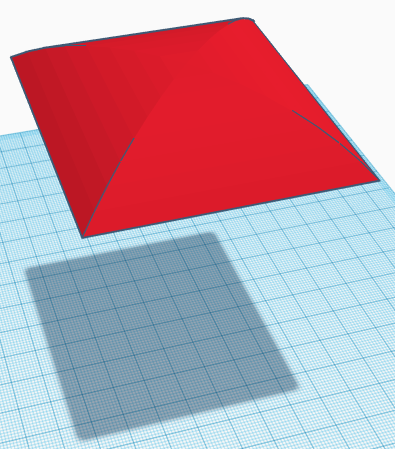 One-quarter of each cap is part of a sphere.
One-quarter of each cap is part of a sphere.
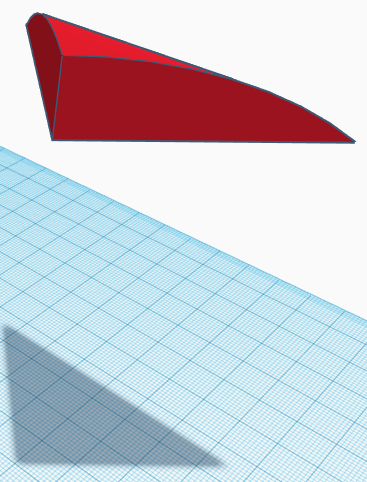 so viewing this down the middle shows half a segment of a circle
so viewing this down the middle shows half a segment of a circle
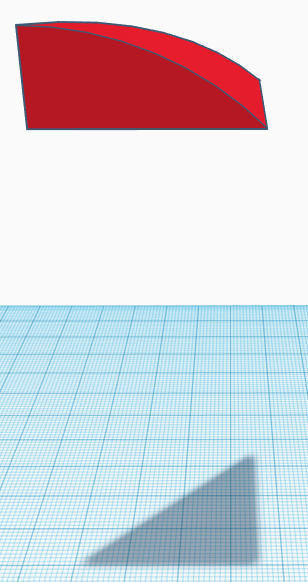 travelling across the bottom, the height is
1
−
x
2
−
2
2
and width is
2
x
travelling across the bottom, the height is
1
−
x
2
−
2
2
and width is
2
x
so the volume of this quarter-cap is to integrate the product of these from 0 to 2 2 which is about . 0 7 7 4 1
Multiply this by 2 4 and add the cube 2 3 = 2 . 8 2 8 4 and get 4 . 6 8 6
(Incidentally, I used Tinkercad for these drawings. It's not the fanciest, but it gets the job done. Plus I'm now ready to 3-d print this cool shape)
Haha, I've solved almost the same way. Great!
We can dissect this solid into a cube of side 2 and six caps with a base of 2 . The volume is
( 2 ) 3 + 6 ∫ 2 1 1 ( 2 1 − x 2 ) 2 d x = 1 6 − 8 2
where x is the distance from the center of the solid. The cross sections of the caps are squares, with side length of 2 1 − x 2
Hint: The equations of this solid are
x
2
+
y
2
<
1
∧
x
2
+
z
2
<
1
∧
y
2
+
z
2
<
1
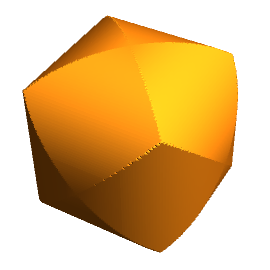 The solid is called tricylinder. The exact answer is
1
6
−
8
2
.
The solid is called tricylinder. The exact answer is
1
6
−
8
2
.
@Albert Lau Why is this the maximum??? And, how did you compute the volume???
Log in to reply
Imagine a 2x2x2 cube, now look from x-axis, we see a square. Imagine a unit circle, carve away the part that is outside the circle. We will get a cylinder. The equation of this cylinder is y^2+z^2<1. Do the same from y-axis, z-axis view. Since we carved away the least amount, the remaining has the maximum volume. Hopefully this gives you the intuition.
To compute the volume, we need integration, which is long and messy to type in latex. Here are some links:
http://paulbourke.net/geometry/cylinders/
http://mathworld.wolfram.com/SteinmetzSolid.html
https://en.wikipedia.org/wiki/Steinmetz_solid
Log in to reply
Ok.....thanks for the information!!!! This is some amazing new stuff!!!!
You have to substantiate the claim that we carved away the least amount (though I agree it is intuitively obvious)
For example, how do you know that carving away ( y − 0 . 1 ) 2 + ( z + 0 . 1 ) 2 < 1 doesn't carve away a smaller volume?
Log in to reply
@Calvin Lin – carving away off-centered circle from a cube (square from front view), the silhouette wouldnt be a circle, will it?
the explanation in the comment is indeed not rigorous, im just giving intuition. there are better solutions below here. and i provide some links if they are interested.
is there a name for this shape?
Log in to reply
Its called tricylinder, a member of Steinmetz Solid.
http://paulbourke.net/geometry/cylinders/
http://mathworld.wolfram.com/SteinmetzSolid.html
https://en.wikipedia.org/wiki/Steinmetz_solid
Whilst not as elegant as the other solutions, this problem is reasonably easy to solve via Monte-Carlo simulation. One (admittedly rough) approach to this is to take a random sample of points from the uniform distribution over a cube of side length two centred on the origin and, for each point, test whether it is within the unit circle as seen from the three axes. We then simply multiply the proportion of points passing the test by the volume of the cube and reach an estimate.
The following code tested ten million points in around 125 seconds and consistently gave an answer within 0.002 of the actual solution.
1 2 3 4 5 6 7 8 9 10 11 12 13 14 15 16 |
|
In fact you could simplify a little bit by only taking ponts p€(0,1)^3 (from the first octant) so that you don't need to map the random numbers and the ratio reminds the same due to simetry.
The solid with maximum volume is tricylinder, the intersection of three cylinders:
⎩ ⎪ ⎨ ⎪ ⎧ x 2 + y 2 ≤ 1 x 2 + z 2 ≤ 1 y 2 + z 2 ≤ 1 .
The cross-section of the solid in a plane perpendicular to the z -axis and passing through the point ( 0 , 0 , z ) , whose area is denoted by A ( z ) , is given by
{ ( x , y ) ∣ x 2 + y 2 ≤ 1 , ∣ x ∣ ≤ 1 − z 2 , ∣ y ∣ ≤ 1 − z 2 } ,
where − 1 ≤ z ≤ 1 . See the animation with Desmos.
Therefore, we have
A ( z ) = ⎩ ⎪ ⎨ ⎪ ⎧ 4 ( 1 − z 2 ) , π − 4 arcsin z + 4 z 1 − z 2 , z 2 ≥ 2 1 z 2 ≤ 2 1
Using the definition of volume, we get volume of the solid
V = ∫ − 1 1 A ( z ) d z = 2 ( ∫ 0 1 / 2 ( π − 4 arcsin z + 4 z 1 − z 2 ) d z + ∫ 1 / 2 1 4 ( 1 − z 2 ) d z ) = 1 6 − 8 2 .